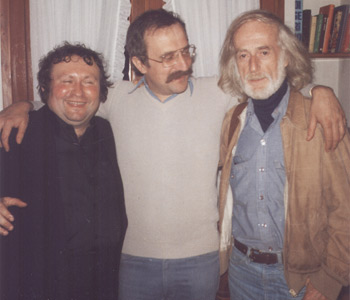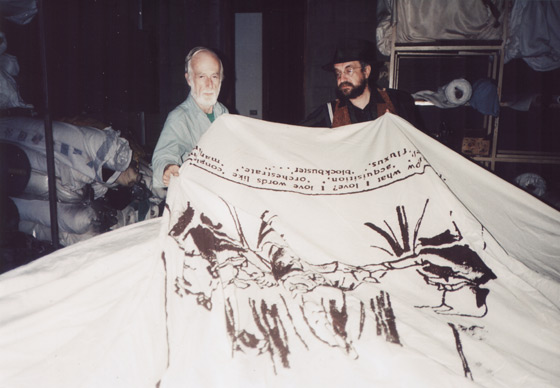

Francesco Conz
Flux Med & Doctor Bob
I met Bob Watts in 1974, in New York, during my first visit to the United States. This was the start of a long friendship that found its culmination in various editions, as well in a number of unique works and in frequent visits to one another. It continued until his death. Bob was one of the very first guests to come to Asolo, which quickly became a dynamic center of cultural activity for a wide range of artists from the entire spectrum of Avant-garde art: from Fluxus to Viennese Actionism, from Poesia Visiva to Zaj, and many more. Joe Jones, an artist and composer, made his home in Asolo for six years, and he introduced me to numerous artists. Watts was one of the people whom Joe insisted I had to meet.
Some of the others whom I met and who worked in Asolo were Charlotte Moorman, Nam June Paik, Takako Saito, Milan Knižák, Philip Corner, Alison Knowles, Dick Higgins, Carolee Schneemann Emmett Williams, Geoff Hendricks, and Daniel Spoerri, as well as Hermann Nitsch, Günter Brus and Otto Mühl, in addition to many others. Numerous works — both regular editions and unique pieces — were created with materials that were made available there, even though they were quite uncommon, such as large-scale canvases for hand-made silkscreen works. The process applied to create these pieces was always directly supervised by the artists themselves, and the same artists often made painterly interventions by hand during or directly after their printing.

Asolo, 1978; Hermann Nitsch, Francesco Conz, Bob Watts
The relationship with Bob Watts was very special, since he was blessed with a powerful, innovative spirit — a spirit of experimentation — that carried Editions F. Conz to a very high level of quality: the work we published was very different from the commercial art world products that were elsewhere so typical of that period.
Bob was one of several Fluxus people — George Brecht and Robert Filliou are other prime examples — who had real backgrounds, and indeed careers, in science, and all of them proved to be pioneers in the exploration of the intersections between artistic and scientific endeavor, as must also be said of Eric Andersen and Larry Miller.
This is also partly seen in the work Bob did on the basis of a book I gave him shortly after leaving my home in Asolo and moving on to Verona. It was a medical and anatomical textbook that had been published in Paris in the late 1800s.

Bangor, Pennsylvania, 1986: Bob Watts preparing the project for “Flux Med”
photo: Francesco Conz
Inviting Bob to take a look at that book and to re-elaborate its images was like having invited a starving man to dinner. He completed twenty-eight works, nineteen of which were subsequently chosen for the silkscreens on cloth which are now presented for the very first time in Budapest, at Artpool.
My family’s origins are Austro-Hungarian, and it strikes me as right that these works by Bob Watts be preserved for the future in a country from which my ancestors once departed. The photographs which accompany the donation of the works on cloth provide further historical documentation that portrays Bob Watts in the course of his interventions in the silkscreen shop in Como, as well as while he was making the original collages.

Como, 1987: Watts and Conz working in the Silk Screen Printing Lab
Photo by Archivio F. Conz
I see these works and the photos that flank them as a truly authentic image of a man whose dedication to art was total, and whose ideas were far in advance of the times in which he lived.
Verona, March 2008
Published in: Robert Watts. Flux Med, exhibition catalogue, Artpool, Budapest, 2008, pp. 3-6.
